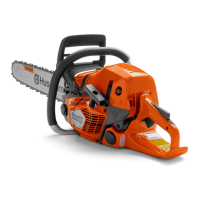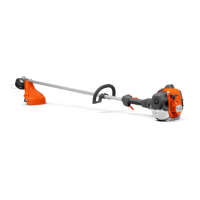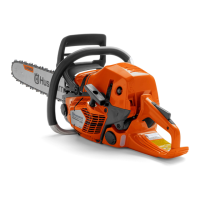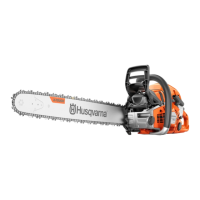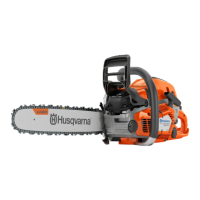Storage
• Always put the product away safely when not in
operation. Leakages and fumes from the product can
touch sparks, naked flames from electrical
equipment, electrical mowers, relays/switches,
boilers and more.
• Always save fuel in an approved container.
• Empty the fuel tank and the chain oil tank when the
product is in storage for longer periods of time.
Discard used fluids correctly.
• Put the transportation guard on the cutting
attachment during storage to prevent injuries.
• Remove the spark plug cap from the spark plug and
engage the chain brake before storage.
Technical data
unit
120 Mark II
(P02138HV)
Engine specifications
Cylinder displacement cm
3
38
Spark plug Champion RCJ7Y
Electrode gap mm (in) 0.5 (0.02)
Fuel tank volume cm
3
300
Idle speed min
-1
2800-3200
Power output at 9000 min
-1
kW 1.4
Emission durability period h 50
Noise and vibration data
Equivalent vibration levels, a
hveq
front handle
1
m/s
2
5.3
Equivalent vibration levels, a
hveq
rear handle
2
m/s
2
6.7
Sound power level, guaranteed (L
WA
)
3
dB(A) 116
Sound power level, measured
4
dB(A) 113
Sound pressure level at operator's ear
5
dB(A) 100
Product dimensions
Weight (excluding cutting equipment) kg 4,9
Oil tank volume cm
3
200
1
Equivalent vibration level, according to ISO 22867, is calculated as the time-weighted energy total for vibration
levels under various working conditions. Reported data for equivalent vibration level has a typical statistical
dispersion (standard deviation) of 1 m/s
2
.
2
Equivalent vibration level, according to ISO 22867, is calculated as the time-weighted energy total for vibration
levels under various working conditions. Reported data for equivalent vibration level has a typical statistical
dispersion (standard deviation) of 1 m/s
2
.
3
Noise emissions in the environment measured as sound power (L
WA
).
4
Noise emissions in the environment measured as sound power (L
WA
).
5
Equivalent sound pressure level is calculated as the time-weighted energy total for different sound pressure
levels under various working conditions. Typical statistical dispersion for equivalent sound pressure level is a
standard deviation of 1 dB(A).
24 657 - 006 -
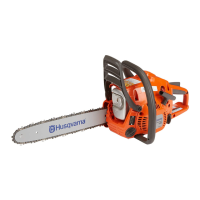
